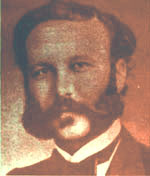

On 24 June 1859, the armies of imperial austria and the Franco- Sardinian alliance fought a day-long battle near the northern Italian village of Solferino. The casualties were heavy- some 40,000 dead, wounded or missing.military medical services at the time were virtually non-existent; as a result there was greatsuffering and many of the wounded died for lack of care. The injured were brought to the surrounding villages for whatever treatment they cound get. In the church at Castiglione, a young Swiss called Henry Dunant, horrified by the agony of the soldiers, began to organize help with the aid of the local people. Returning home to Geneva, still haunted by what he had seen, he wrote a book about his experience. "A Memory of Solferino" , published in 1862, was acclaimed throughout Europe. In it,Dunant put forward an idea for supplementing armymedicalservices in times of war. This would be done through national relief societies which, in peacetime, would train their voluntary members for this work. Dunant also proposed that the wounded, and all those attending them, should be regarded as neutral, even on the battlefield.
To help promote the aims of the book, four citizens of Geneva - Gustave Moynier, who was President of
the Geneva Public Welfare Society. General Guilaume-henri Dufour, Dr. Louis Appia and Dr. Theodore
Maunoir-joined Dunant in setting up the "International Committee of Red Cross ( ICRC ).
Im response to an invitation from the International Committee, specialists from 16 coutries met in Geneva in October 1863 . They adopted ten resolutions that made up the founding charter of the Red Cross,
defining the functions and working methods of the Committee for the Relief of the Wounded which Dunant had proposed. The Movement was born For the International Committee, the major task still lay ahead : persuading government that the wounded and those caring for them should not be considerated adversaries, since they were not - or no longer - taking part in the fighting, and therefore needed protection. This concept of neutrality would have to be embodied in an international treaty providing for a protective emblem to be used by all armies, to identify medical personnel, hospitals and ambulances.
To this end Swii Government undertook to convene, in Geneva, a diplomatic conference, to be held in
August 1864. Delegates of 12 government took part. and adopted a draft treaty prepared by the
International Committee.the agreement was called the " Geneva Convention for the Amelioration of the
Condition of the Wounded in Armies in the Field.
This treaty, with its ten articles, was a milestone in the history of humanity. war andlaw had, util ten, benn considerated irreconcilable. The founders of Red Cross argued, however, that law could apply even during war, and could regulate, in certain respects, the conduct of soldiers.
From then on ambulances, military hospitals and medicla staff were to be "recognised as neutral and, as
such, protected and respected by the belligerents... Wounded or sick combatants, to whatever nation they belong, shall be collected and care for". At the same time the red cross on a white ground (the Swiss flag reversed), which had been adopted in 1863 as the symbol of the embryonic Red Cross movement, was incorporated in the treaty as the proctective emblem of the military medical services.
The emblem of a red cross on a white ground was created with a specific purpose: to ensure the protection of those wonded in war and those who care for them. any misuse of this sign instituted bythe Geneva Convention of 1864 - for example, by transporting armed troops in an ambulance, or by flying a red cross flag over a munitions dump - is not only a breach of international law but also threatens the very notion of protection granted by the emblem.
To prevent such breaches, States party to the Geneva Conventions must issue strict regulations on the use of the emblem. It may only be displayed on vehicles, aircraft, ships, buildings and installations assiged to transport and shelter the wounded, and worn by the personnel who care for them. it is forbidden to use the emblem for commercial or publicity purposes. Natinal Red Cross and Red Crescent Societies are also allowed to use the emblem to identify their premises, vehicles and equipment, as well as their staff, who often wear a uniform or badge. In this case the emblem must be small, so as not to be confused with the wartime protective sigh.
The 1864 Convention mentioned only the red cross. A second emblem made its appearancea few years
later, and it still in use - the red crescent .The cross had been adopted as a triibute to Switserland, and had not been intended to have any religious significance; in 1876, however, during the Russo- Turkish war, the Ottoman Siciety for Relief to the Wounded replaced it by a red crescent.
This tmblem has since been adopted by a number or countries in the Islamic world. It is recognized as
having equal status with the red cross, and as such is mentioned in 1949 Geneva COnventions and their
Additional ProtocolsCaring for the wounded in war, helping the mentally and physically handicapped, visiting detainees, bring
relief to earthquake victims, restoring contract between relatives seperated by conflict, giving courses in
child care and hygiene, encouraging blood donation, protecting the population in occupied territoty - the
activities are diverse, but they all have one porpose: to help those who suffer, without discrimination.
Today, more than a century after henry Dunant's humanitarian initiative on the battlefield of Solferino, the international Red Cross and Red Crescent Movement is active in 150 countries throughout the world.
This booklet sketches the portrait of the Movement, showing how it began and what it is today.
[HOME]
HISTORY
[ DETAILS ] [ ACTIVITY
]
[ SONG
] [ E-MAIL ] [ LINK
]
[
GUEST BOOK ]
[ 3rd
PBSM DAY ]